Roma Khetarpal's Blog, page 14
September 13, 2017
Avoiding Emotional Disasters During Natural Disasters
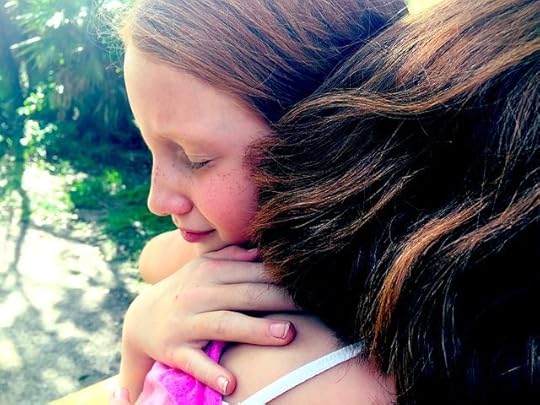
In the past few weeks, every time I’ve turned the TV or hopped onto social media, it seems that all I’ve seen is devastation—hurricanes in Texas and Florida, a huge earthquake in Mexico. Coverage of the damage to property, both personal and public, and the havoc wreaked on families and children everywhere triggers a slew of emotions—sadness, compassion, empathy, sympathy, fear, to name just a few.
While we are eager to keep up to date on current events, let’s be truthful here, we are slightly addicted to bad news. That’s no fault of our own; it’s part of human nature.
Research has shown that humans seek out news of dramatic, negative events in part because our brains evolved in a hunter-gatherer environment where anything novel had to be attended to immediately for survival. Other studies have shown that our negative brain tripwires are far more sensitive than our positive triggers. We tend to get more fearful than happy. And each time we experience fear we turn on our stress hormones.
And what about our children? Are their stress hormones being turned on as well? Of course they are! So how can parents help them avoid emotional disasters during natural disasters?
First things first: Begin by managing your own stress. Having concern and compassion during a natural disaster is one thing, but expressing those feelings repeatedly simply increases your stress and that of your family. As parents, it is our job to be responsive and not reactive. Recognize there are things we have control over and things we do not. Be compassionate, kind, and offer help, but stop hitting replay in your mind. Times like these are not only opportunities to plan for things that we never thought would happen to us, they also allow us to model how to face the unexpected challenges of life. Respond in a manner that you would want your kids to respond.
As for specific actions to take with your kids, that depends on how old they are. If your child is:
Under age 5—keep your kids away from this stress. Do not have the news blasting from every medium. In particular, keep the TV off. You can follow the news yourself more discreetly every few hours. Twitter is a great resource for short, to-the-point updates.
Between 5 and 10—and is asking about or talking about a disaster, be mindful of your tone of voice and choice of words. Keep your own emotions out of the equation, and in a calm tone of voice, say that natural disasters are unpredictable—you can use the word “surprising” for younger kids—but as scary as they are, friends, family, the community, and local and national governments all come together to help each other. Highlight the goodness of human nature and shift the conversation in a more positive direction. You can also do a quick Dealing with the Feeling , an emotional intelligence and mindfulness tool that I teach to parents and adults managing young children. Address the feelings, acknowledge them, and then move to comfort. Be sure to give hugs, hold hands, and generally use the power of touch. (It’ll do wonders for you as well.) Dr. Dachner Keltner of the Greater Good Science Center in his research has shown that touch is fundamental to human communication, bonding, and health.
A tween or teen—he or she is as exposed to the news on social media as you are. Feel free to enforce temporary digital boundaries if you feel their moods are being affected. Dr. Dan Siegel in his book, The Power and Purpose of the Teenage Brain, explains that teenagers and adolescents experience a change in levels of dopamine, a chemical in the brain. This prepares kids to be independent but also puts them at a higher risk of anything that can be addictive, from online gaming, to drugs, alcohol, and even bad news. Help them make good choices and monitor them—not in an intrusive way but by keeping an open dialogue going. Children in this age group are also less likely to express their emotions. Plug in an age-appropriate Dealing with the Feeling here as well.
An adolescent or young adult—open up a dialogue with them. Once our kids are out of sight, we assume that they are grown up. But those who have recently left home or are in college may have fears like “what if this happens to me, while I’m away from home.” Discuss emergency plans with them, and if you don’t have an emergency plan, set one up! Here’s a great resource to get you started: Make a Plan. Unless you are in a danger zone, take a few days and chart out a plan first. More importantly, keep your finger off the panic button, so you don’t panic your kids who are away from home.
Regardless of your children’s age, there are positive actions you can take to uplift your family’s mood. Begin by helping others through the various donation hubs set up for a disaster. Ask your kids to contribute from their own allowance, even as little as a dollar. The best way to express compassion is by being compassionate. It soothes our heart and warms our soul while increasing human connection.
Our Tools of Growth family sends positive vibes and prayers to the families affected by these natural disasters.
The post Avoiding Emotional Disasters During Natural Disasters appeared first on Tools of Growth.
September 6, 2017
Parenting Tips That Show You How You Can Be The “Perfect” Parent
Last week, I had the pleasure of sitting down with Josh Ochs from SmartSocial.com to discuss my award-winning book, The “Perfect” Parent. The discussion centered on the tools that can make us all better parents, especially in the digital age we are living in.
Approachable parenting builds trust.
Sensible parenting builds connection.
Reasonable and responsible parenting builds understanding.
When you are right, practice being kind first.
Align your intentions with your goal.
If you haven’t picked up the book yet, this will be a great introduction to what you’ll learn from reading it. If you’re already a fan, you’ll love these reminders.
Watch the video and let us know how you are the “perfect” parent for your child.
The post Parenting Tips That Show You How You Can Be The “Perfect” Parent appeared first on Tools of Growth.
August 22, 2017
A FAB Mom and Her Empowering Book
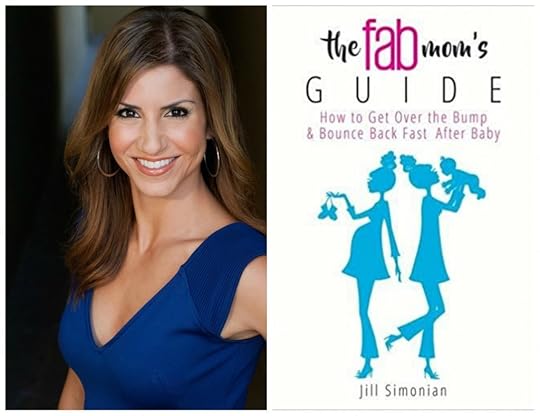
Last year I got an email from Jill Simonian, a lovely lady who invited me to join her on a FB Live segment on CBS LA’s Facebook page. I checked out the website of this FAB Mom—FAB=Focus After Baby —and I loved her energy, authentic voice, and message of mindful parenting while “keeping your groove on.” Those of us who have watched Jill know she is contagious! You can’t just like her… you fall in love with her.
A couple of months ago she released her first book, The FAB Mom’s Guide: How to Get Over the Bump & Bounce Back After Baby, and I couldn’t wait to get my hands on it. Then I couldn’t put it down. She was real and relatable from the moment she explained why she wrote the book: “The loneliness of being a brand-new mother blind-sided me—I was the girl who always preferred to go shopping by myself, found comfort taking in an afternoon movie alone, and even savored having lunch totally solo before the days of smart phone companionship. But now, with a newborn, I felt lost.”
Jill’s book combines her clear perspective, clever tools and tips, and belly-laughing humor. I love the fact that she discovered many of her tools through her own personal experience in life and as a new mom. There’s a piece called “Tit’s up” that I’m not giving away here!
One of my favorite sections—it’s hard to pick just one—is “Loud Love With Your Baby.” She describes how she confronted her loneliness head on by partnering with her new baby. She would talk out loud, sing, and dance in the way one person would relate to another adult, not cooing or using baby language. No wonder her daughter was fully talking after a year and half.
She handled her baby’s crying as conversation as well. She noted, “I interpreted her crying in a way that helped me on a personal level: I reminded myself she was talking to me.” How brilliant is that. A crying baby often means frustration for a new mom, but Jill embraced patience instead. I wish I had had an inspiring guide full of Focus After Baby nuggets when my kids were little. She covers the entire spectrum of challenges—internal and external—with new dads, family and friends, body image, social media, chores, lack of sleep, and many more.
What I loved most about this useful, relatable, and thoroughly enjoyable read is that Jill reminds us to see our children as “real people.” As an advocate of mindful and conscious parenting, I know that seeing children as real people, no matter how young they are, is at the core of building lasting relationships with our kids.
I believe Jill’s book and message goes beyond pregnancy, childbirth, and motherhood and belongs with books on mindful parenting, conscious parenting, motivation, personal growth, and self-help. Yes, it’s a simple DIY book, but it also nurtures the spirit and leads us to mindful and conscious living.
Order your copy here and be sure to write a review!
In Joy!
The post A FAB Mom and Her Empowering Book appeared first on Tools of Growth.
August 10, 2017
On Life and Death – A Conversation with My Kids
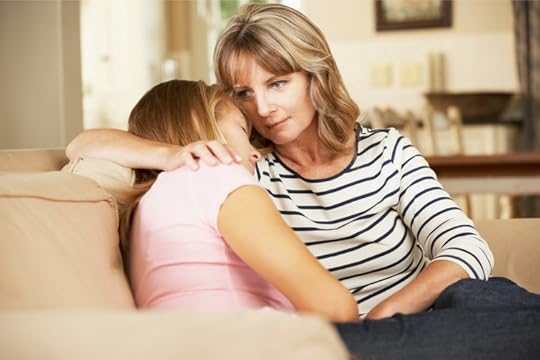
This year alone, my young adult children have lost four friends—one to a drug overdose, one to addiction-related suicide, one to cancer, and one to a freak motorcycle accident. Whether death is accidental, unexpected, or intentional, it commonly leaves us with some big and troubling questions:
Why did this happen to him/her/their family/me? That question can never be answered clearly, no matter how many layers you peel back as you try to discover what led to the incident.
What if this could have been prevented… if they got help, or if I did something, or if someone had been around to save them? Again, regardless of the imaginary scenarios we create, this question can never be answered with clarity.
How can I ensure that this doesn’t happen again to anyone I know? How can I make sure that no one else feels this pain? Alas, there is no way to completely eradicate deaths due to substance abuse, illness, or accidents. Certainly we can make a difference and raise awareness of problems, but as we find a cure to one human illness, a new one seems to take its place. And as one drug is taken off the streets, another one is invented. Such is the nature of life.
So, my dear children, as I watch you enter adulthood facing—head on—the unpredictable, untimely, inevitable, and unavoidable end of lives dear to you, I ask myself what I can tell you. What will carry you through this beautiful life without your being consumed for too long by sadness, anxiety, or fear? There are three simple things to know:
Life is never complete without death.
They are two sides of a coin; one cannot happen without the other. Life ends in death, and death brings new life. This is the circle of life—one that has existed before we arrived and will continue after we leave. If you accept that truth, you will be free from the burden of fear. Don’t dance around death and cloak it with so much fear that it sucks the vitality out of you. When we avoid death, we lose the essence of life; we rob ourselves of its joy. If we spend our all our days fearing what we all know has to happen, that would be a terrible waste of life. We cannot look at death as the opposite of life. It is very much a part of it. The better answer is to…
Accept death.
When we accept that death is a part of life, we commit to living fully. If you accept that I may die tomorrow, you will enjoy every moment with me today. This is truly how we should live our lives—by being present, attentive, compassionate, kind, and enjoying the gift of life and the relationships we have. As Norman Cousins once said, “Death is not the greatest loss in life. The greatest loss is what dies inside us while we live.
Yes, if I die, you will feel sad and you will miss me, but if you accept death as a part of life, those feelings of sadness will pass. Feelings are like waves; they come and go. They are impermanent. Of course, even if you accept death, you must cope with a time of sadness. Where should you turn in the moment when you feel bereft? What should you do? There is only one way…
Know who you are.
I’m not referring to knowing your physical self, your identity, or your personality. That you undoubtedly already know. But what about the you who actually runs the show, the energy that keeps you alive. There is a presence within you that is always attentive. Connect with that awareness. This attention, intuition, inner energy—whatever you want to call it—is ageless. Your essence is the same as it was when you were 5 months or 5, 15, or 25 years old. You can touch this essence through meditation. Make this a daily practice. Close your eyes and turn them inward. For just five minutes every day follow your breath.
There is no greater gift you can give yourself than to befriend your essence. It is yours through ups and downs. It is yours in life and death. It is what will make you go through life without being consumed by it. It is timeless and ever present and common to all of us.
So when you miss those friends who seem to have left you, know that their essence is in your essence. They are always with you. In that awareness, we truly begin to live without fear. And yours will be a life worth living.
The post On Life and Death – A Conversation with My Kids appeared first on Tools of Growth.
August 1, 2017
Mindful
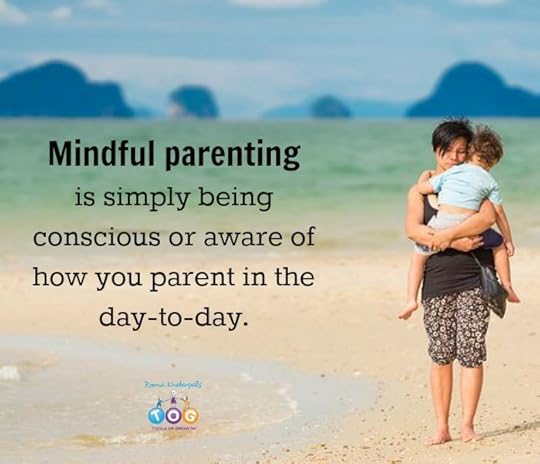
The other day, I heard a parent say, “I can’t do the mindful parenting thing. It’s not my style. I’m not into meditation. It’s too hard for me.”
That comment reinforced something I already knew: When it comes to parenting, the word mindful is easily misunderstood. That probably is the fault of us, the parenting “experts.” To begin with, there are a lot of us, and we come from many different fields. Besides licensed MDs, PhDs, and MFTs, you can find advice from parenting coaches, parenting counselors, mom bloggers, dad bloggers, and parenting authors like myself, and we’ve all gotten creative with the way we describe our approach.
The world of psychology traditionally recognizes four styles of parenting—authoritative, neglectful, permissive, and authoritarian. But now we’ve added other parenting “identities”—Attachment Parenting, Authoritarian Parenting, Responsive Parenting, Positive Parenting, Helicopter Parenting, Nurturant Parenting, Dolphin Parenting, Lawn-Mower Parenting. And on and on. I’m not kidding. Here’s a brief official list on Wikipedia .
Recently, parenting writers like me, who have come out of the positive psychology and self-development movements—which emphasize being “mindful” or in the moment—have drawn on that for other descriptions of parenting styles: Mindful Parenting, Conscious Parenting, Present Parenting, Aware Parenting, and so on. You get the picture.
Where earlier experts tried to help you identify or recognize the style that is tailored to your natural parenting personality, we acknowledge that since every child is different, parents cannot—and should not—restrict themselves and their children to particular parenting styles. Instead, they have to adapt to their children’s personalities, ages, phases of growth, and situations by being mindful or conscious.
So what is mindful parenting? Well, let me start by saying it has nothing to do with meditation. It also is not a Zen or yogic practice. You may never have ever practiced yoga and still be the most mindful parent.
Mindful Parenting is simply being conscious or aware of how you parent in the day-to-day. There are two individuals involved, both you and your child. So mindful parenting means being aware of your child’s thoughts, feelings, and behavior as well as your own. When we pay attention to these inner and outer communication landscapes, we become more present, more alert, and more attentive. We sharpen our day-to-day communication with our kids.
Remember, though, that you have a bigger, long-term goal.
Mindful parenting is keeping an eye on building an open and lasting relationship with our kids. Nothing is more important to us than this. That is every parent’s true intention, goal, purpose, desire, yearning, longing—whatever you want to call it. And we all want that. If we keep this goal in front of us, as we invest our daily time in parenting during good times and challenging ones, we are golden!
That’s it! Mindful parenting simplified.
Learn more about being a mindful parent in The Perfect Parent.
The post Mindful appeared first on Tools of Growth.
July 26, 2017
Banning Phone Sales for Preteens… or Not!

I recently came across this segment on CNN, where a Colorado physician and father joined others in circulating a petition to ban cell phone sales to children under 13. I have read enough research and followed enough conversations with experts to know that the issue is truly a concern. Cutting-edge research confirms that the brain during the teen years leans toward more impulsive behavior, attitudes, and mood swings and is more prone to addictions. How then can we put mobile devices in a teenager’s hands and expect him or her to behave responsibly and not break rules? Are we setting up our tweens and teens for failure? Even if this petition becomes a law—which realistically would take a couple of years—what should parents be doing in the meantime? How can they cope now?
To shed light on this, I phoned a friend who has a great relationship with her kids and is an extremely mindful and open-minded parent. She has three kids—a tween boy and two teen girls. I found her tools and boundaries very much on point. And her roll-up-your-sleeves attitude inspired me to share her ideas.
Here’s her take:
“This is what we do with our kids: We require them to give us their passwords for all electronic devices, and we have Life 360 installed on the phones so we can find out where they are whenever we need to. We also monitor data usage to make sure they aren’t watching YouTube videos all day long. They have to turn everything off when they go to bed so they aren’t watching things in bed at night. Other than that, I’ll periodically take a look at texts when they leave the phone around the house. (They don’t know I’m looking.) I also follow all their social media handles to make sure they aren’t posting anything inappropriate.
“I think people are making setting limits a bigger deal than that needs to be. We make the rules for our kids, and if they don’t abide by them, we take the phones away for the rest of the day. We’ve done that a few times with one daughter, and, believe me, she learned her lesson. I am not tracking them all day long—only once in a blue moon. Plus, when they know we have their passwords, the kids are less likely to post anything inappropriate.
“The good thing is we have a great way of teaching kids how to manage technology properly from an early age. Sure, it’s one more thing to teach, but I think as parents we have to do that.
“My kids are much more likely to ‘talk’ to me via a text. If they are upset or angry with me, they write it out, and then we go back and forth with a text discussion. Ideally, I’m sure it would be better to talk face to face, but I’d rather have the discussion over text than not have it at all. It’s much easier for kids to voice their feelings when they aren’t staring into their parent’s eyes.
“It’s up to us to set limits. We don’t have to interfere with their personal space, but it’s perfectly okay to say no electronics at mealtimes or after going to bed. It’s also okay to say you want the kids to get an hour of exercise outdoors every day (without the phones). But other than that, I do think you have to leave them alone. Sure, sometimes my kids use their iPads excessively, but I let it slide. It isn’t worth getting on their case about everything!”
“When I was a kid, my mother got on my case about always being up in my room reading books. Really, with kids, there is always something to complain about.”
This is what exactly what parenting is all about. It’s a balancing act. In order to build an open and lasting relationship with her kids, this forward-thinking mom uses some all-important traits. She is:
Firm yet kind. Kids need boundaries and guidelines around technology. Have one simple consequence—you’ll lose your gadget for x amount of time—and deliver it firmly yet kindly. No mocking or sarcasm. As I say in my book, The Perfect Parent , “When you are right, practice being kind first.” It’s the easiest way to communicate effectively!
Flexible. Know when to bend without breaking. If you have a good system in place around technology and your kids mostly follow through, you can sometimes let things slide. Military-style parenting has never worked for any age group, especially teens. Letting them know that you are turning the other cheek “this time” is another great way to build camaraderie and ensure future compliance.
Creative. This is a must and helps us find ways to open up the dialogue with kids. Take texting. She says, “I’d rather have the discussion over text than not have it at all.” That really resonated with me. If all of us had such foresight in parenting our children—especially in the face of challenges—we would find much more joy in parenting.
What are your thoughts? Please share what has worked for you.
The post Banning Phone Sales for Preteens… or Not! appeared first on Tools of Growth.
July 20, 2017
“Put That Cell Phone Down Now!”
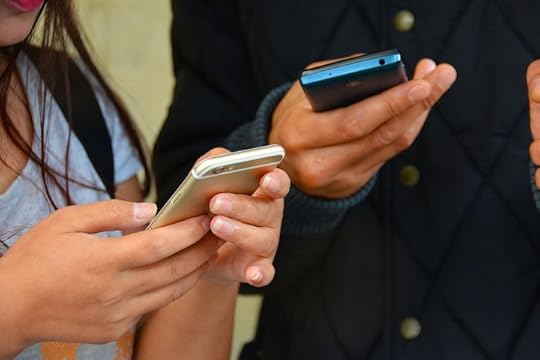
As much as we look forward to breaking the monotony of our daily routine over the summer, a new routine can be extremely challenging for parents. Yes, we get a break from the daily grind and the emotional load of school-year life, but when kids have more free time, we can be overwhelmed and confused with the headache and heartache of their over-use of mobile gadgets and pretty much at a loss at how to deal with it. What’s a giant issue during the school year seems to escalate into a monster over the summer. In the last month alone, most of my parental coaching sessions and workshop discussions have revolved around the “mobile beast.” Here are some of the comments I’ve heard:
“I’m so tired of my own voice saying, ‘Put that cell phone down now!’”
“It’s a losing battle! I give up!”
“I’m tired of competing with the mobile. It has way more to offer than I ever will!”
“I’m through struggling to find creative distractions from their mobile devices.”
“It’s an addiction: I have it. My husband has it. My kids have it. I don’t know what to do!”’
The struggle is not just real, it is surreal. Here’s why:
We are the first generation to have to monitor mobile-device usage. Our parents never had this problem. And with no guidelines on usage nor information from the manufacturers on the hazards of over-use, we are left to figure things out on our own. Moreover, the information online is excessive and fear mongering. Often it seems too much to tackle.
This struggle is as much ours as it is that of our kids. While we are quick to draw boundaries around our children’s mobile-phone use, we find every excuse in the book not to manage our own. Stay-at-home moms confess that they can Candy-Crush for hours while their kids are at school, and working moms admit that after hours they use work as an excuse to catch up with social media. And despite common sense, many parents use their cell phones during dinner and while driving their children around.
So what can we do?
Fire-up your parental instinct. While we might lack specific instructions from experts and mobile-device manufacturers, we can definitely draw inspiration from new research pointing to the repercussions of short-term and long-term cell phone over-use. Educate yourself and your kids. This will help put the very first brakes on. As a parent, the well-being of your children is not just your job, it is your responsibility and obligation. Parenting is loaded with unknowns, and this one is no different. Seek professional help if you need to. There are more parenting coaches and professionals today than ever before. But keep in mind that nothing trumps your own parenting instinct about getting the process started.
Lean on your parental intuition. There are two things to remember here:
a) Monkey see, monkey do. You have to set the stage and take the lead. Follow the guidelines that you draw for your children. In order to be role models, we have to be good rule models.
b) You know your kids best. Use your intuition to draw guidelines and boundaries. And, yes, they will be different for each child, because each child is different. No one knows them better than you.
Be patient, disciplined, and flexible. Realize there will be a transition period. Habits—especially addictive ones, like the use of technology—cannot be discarded in a day. Your children will kick, scream, and resist, no matter their age. You are the captain of the ship, however, and you will have to ride the storm out with patience, discipline, and tenacity. You might even have to modify and update your guidelines. In order to lead children we have to be flexible—that is, to be able to bend without breaking. As singer Jimmy Dean once advised, in order to get to your destination, be ready to adjust your sails in the direction of the wind.
This small effort will definitely beat the amount of energy you spend on the repeated and often unfruitful, “Put your cell phone down now!’
The post “Put That Cell Phone Down Now!” appeared first on Tools of Growth.
Put That Cell Phone Down Now!

As much as we look forward to breaking the monotony of our daily routine over the summer, a new routine can be extremely challenging for parents. Yes, we get a break from the daily grind and the emotional load of school-year life, but when kids have more free time, we can be overwhelmed and confused with the headache and heartache of their over-use of mobile gadgets and pretty much at a loss at how to deal with it. What’s a giant issue during the school year seems to escalate into a monster over the summer. In the last month alone, most of my parental coaching sessions and workshop discussions have revolved around the “mobile beast.” Here are some of the comments I’ve heard:
“I’m so tired of my own voice saying, ‘Put that cell phone down now!’”
“It’s a losing battle! I give up!”
“I’m tired of competing with the mobile. It has way more to offer than I ever will!”
“I’m through struggling to find creative distractions from their mobile devices.”
“It’s an addiction: I have it. My husband has it. My kids have it. I don’t know what to do!”’
The struggle is not just real, it is surreal. Here’s why:
We are the first generation to have to monitor mobile-device usage. Our parents never had this problem. And with no guidelines on usage nor information from the manufacturers on the hazards of over-use, we are left to figure things out on our own. Moreover, the information online is excessive and fear mongering. Often it seems too much to tackle.
This struggle is as much ours as it is that of our kids. While we are quick to draw boundaries around our children’s mobile-phone use, we find every excuse in the book not to manage our own. Stay-at-home moms confess that they can Candy-Crush for hours while their kids are at school, and working moms admit that after hours they use work as an excuse to catch up with social media. And despite common sense, many parents use their cell phones during dinner and while driving their children around.
So what can we do?
Fire-up your parental instinct. While we might lack specific instructions from experts and mobile-device manufacturers, we can definitely draw inspiration from new research pointing to the repercussions of short-term and long-term cell phone over-use. Educate yourself and your kids. This will help put the very first brakes on. As a parent, the well-being of your children is not just your job, it is your responsibility and obligation. Parenting is loaded with unknowns, and this one is no different. Seek professional help if you need to. There are more parenting coaches and professionals today than ever before. But keep in mind that nothing trumps your own parenting instinct about getting the process started.
Lean on your parental intuition. There are two things to remember here:
a) Monkey see, monkey do. You have to set the stage and take the lead. Follow the guidelines that you draw for your children. In order to be role models, we have to be good rule models.
b) You know your kids best. Use your intuition to draw guidelines and boundaries. And, yes, they will be different for each child, because each child is different. No one knows them better than you.
Be patient, disciplined, and flexible. Realize there will be a transition period. Habits—especially addictive ones, like the use of technology—cannot be discarded in a day. Your children will kick, scream, and resist, no matter their age. You are the captain of the ship, however, and you will have to ride the storm out with patience, discipline, and tenacity. You might even have to modify and update your guidelines. In order to lead children we have to be flexible—that is, to be able to bend without breaking. As singer Jimmy Dean once advised, in order to get to your destination, be ready to adjust your sails in the direction of the wind.
This small effort will definitely beat the amount of energy you spend on the repeated and often unfruitful, “Put your cell phone down now!’
The post Put That Cell Phone Down Now! appeared first on Tools of Growth.
July 10, 2017
Taking the Time to Listen with Kids
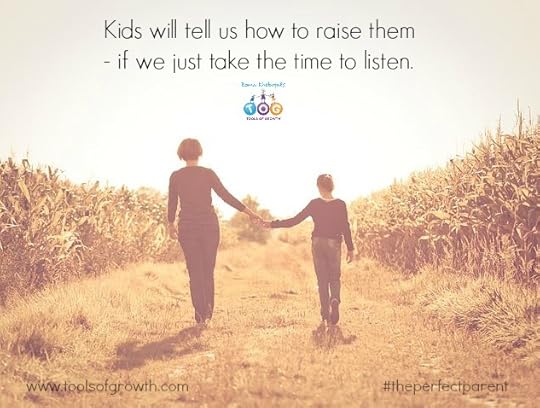
Julius Cesar said, “Experience is the teacher of all things.” In all my parenting workshops, talks, and consultations, I advocate that parents try the tools that I give them and then “experience” the new experience. The experience will teach you what you need to learn, and you can decide whether or not you want to keep the tool or drop it. It warms my heart when parents commit to this and share what happened when they broke new ground
Here’s one parent’s story:
Every day getting to school was an absolute battle with my five-year-old daughter. I tried being kind and playful, talking about it, playing games, bribing her, rewarding, scolding, punishing, threatening, and yelling. But the battles continued, and I was tired of it. My daughter didn’t like me, and I had run out of patience. Every evening, when I was putting her clothes out for the next morning, she would say, “I don’t like school,” or “I don’t want to go to school,” or “why do I have to go to school?” That was her daily mantra. And every day, I would answer in some smart way, indicating that she had to go; she had no choice. We were both starting to feel the tension and the disconnect.
Then I remembered what you had recently told me about recurring issues: that our approach needs to be updated because the existing one is not working. But I thought I had tried everything. I had checked in with the teachers at school to see how she was doing almost every week. My daughter was thriving socially and academically, but we were still battling about going to school every morning. I just couldn’t put my thumb on why. I even told my husband that I was concerned about the long-term effects of this on my daughter. After all, she had just started school last September. What would happen in five years, I wondered.
Then something magical happened one night. As I was putting her clothes out, and she was chanting her daily, “Why do I have to go to school? I don’t want to go to school. I don’t even like school,” I decided not to answer. Instead, I decided to try Take 5 . I had nothing to lose. I had tried everything else. I remembered the examples from your book about sharing quiet space with kids and doing no-thing for 5 minutes every day and just went for it.
I stopped what I was doing and sat on her bed. I wasn’t upset. If anything, I was simply neutral. I sat there in quiet and took a couple of deep breaths. It seemed like we were quiet for an eternity. My daughter was just quietly observing me. After a minute of silence in this shared space, she said, “Do you know why I don’t like going to school, Mommy? Because I hate getting up in the morning and rushing.”
In an instant, every morning of the past eight or nine months flashed in front of me. I knew that! I’ve always known that my daughter panics when we rush. Why did I not realize this each morning?
All I could think of was, “Duh.” Of course, she’s right! Almost immediately, I came up with a suggestion: “How about I wake you up 30 minutes earlier, so you get to take your time and hang out and get ready without rushing?” She jumped at it. Yes, that meant that I would have to wake up 30 minutes earlier (ugh) but that definitely beat the entering the battlefield every morning.
We are now two weeks in, and the morning chaos is done. My daughter wakes up, hangs out for a bit, sometimes reads or colors, gets ready, and we’re on our way. She even wanted to get to school well before the bell rings, so she doesn’t feel so rushed getting out of the car and running to class. How much simpler could she have made this for me! Or could I have made it for myself! I just needed to take the time to give her quiet space to share her feelings and guide me to a solution. Had I not taken those five minutes to intentionally connect, we would have continued down our battlefield path. We both had to stop to come up with a solution!
I’m a fan of Take 5. I’ve experienced the experience, and I love it.
Kids will tell us how to raise them—if we just take the time to just listen. How easy is that! Need I say more?
This story was related by a TOG follower. Thank you so much for sharing!
The post Taking the Time to Listen with Kids appeared first on Tools of Growth.
June 26, 2017
The Motherhood Evolution with Suzi Lula – Part 1
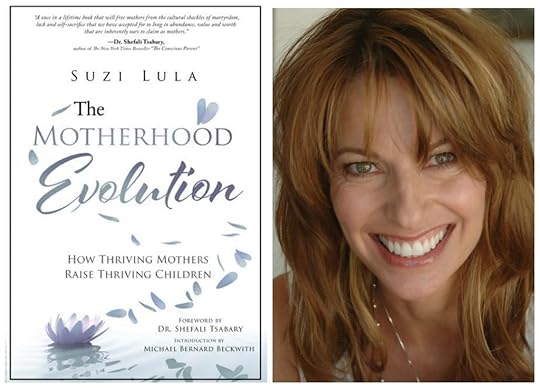
“Self-care is not selfish. You cannot serve from an empty vessel.” – Eleanor Brown
Taking care of ourselves is such an alien concept to most of us moms—something that all of us are guilty of. We know that we should but we just don’t do it. We know intrinsically how to first take care of our kids, partners, parents, siblings (and everyone and everything else) but fall short on listening to what we need to fuel our own spirits. Our dear friend, Suzi Lula, teaches the wisdom of self-care better than anyone else. We thought we’d ask Suzi to share some of that wisdom with us.
1. Suzi, please define The Motherhood Evolution.
The motherhood evolution is “redefining” the way we think about motherhood, creating an entirely new vision of motherhood where all mothers everywhere are thriving. It assists mothers to move from simply surviving to powerfully thriving on our motherhood journey and in our relationship with our children.
When children witness us thriving, we give them permission to thrive.
The motherhood evolution is dedicated to seeing every mother on planet earth thriving. This is my mission.
2. What do we really want out of motherhood? Will self-care—as you define it—get us there?
In my experience working with mothers, all of us want the same thing: a close, deeply connected, intimate relationship with our children, and our children want the same from us. Both mothers and children seek the same thing—we want to be seen, heard, valued, and to know that our life is important and that we matter.
Self-care will absolutely get us there. Self-care is the art and practice of nourishing our heart, our spirit, and our life. When we feel spiritually connected and spiritually fed, when we’re living with an open heart with full self-acceptance, we absolutely feel connected, inspired, and fulfilled from the inside out. And our children will feel this from us!
3. According to statistics, moms today are quite dialed into taking care of themselves. Surveys indicate that money spent on nail salon services has grown 12 percent, hair salon growth is 3 percent, and the women’s health and wellness industry—including yoga and mediation—reports similar trends. In every facet of life, women seem to be leading in self-care. So what different type of self-care are you advocating? Can you share some examples?
While these statistics certainly represent us intellectually knowing that self-care is important, sadly I find that very few mothers have actually created, cultivated, sustained, and maintained a meditation practice, for instance. We intellectually know it’s important, but we haven’t yet embodied that knowledge on a practical, day-to-day basis.
I believe that meditation is the heart of self-care. When we become mothers we need to cultivate a meditation practice that works for us because we are pulled in so many different directions as a mother. Rarely does a mother have 30 uninterrupted minutes to sit down and meditate, so I teach mothers that rather than sitting and trying to “quiet their minds” for 30 uninterrupted minutes, practice something as simple as taking a moment to play a beautiful piece of music, and begin to learn to open your heart—rather than trying to quiet your mind
In my book, I have two chapters devoted to meditation, to assist mothers to find the practical ways that can work for them to create a meditation practice that they can maintain and that will feed them.
Emotional self-care is also a large part of what I teach. Every mother comes to motherhood with our own unresolved issues from our own childhood. The part of self-care that I call “mothering the mother” is also one of the most important self-care practices that we can embark upon. Who mothers the mother? We must!
The self-care that I’m speaking of is something deeper: the practice of caring for our essential, invisible, authentic self—our essence. When we connect to our essence, we model to our children to stay connected to theirs. Therefore, they will stay connected to their true self and won’t have to reconnect with it as an adult. Allowing our children to stay connected to their essential self is the greatest gift we can give them!
4. Can you share 3 tips on how mothers can make self-care a daily spiritual practice? Can it be done without guilt?
Momma guilt is an epidemic in our culture! Once you realize the value of self-care and the deep connection and relationship you will cultivate with your children you will never, for one moment, feel guilty again for taking care of the most important person in your children’s life: you! I never feel guilty anymore for taking care of myself! Never! I’m here to end momma guilt forever!
3 practices:
I have every mother I work with find a photo of herself when she was very young and find a photo of her children when they were very young and simply take a moment every morning or evening to truly look into your own eyes and your children’s eyes in those photos with the intention of connecting to your true essence. This practice is simple, but it connects us with the most powerful part of ourselves.
I also have every mother I work with find 5 or 10 things daily that she appreciates about herself and say it out loud or write it in her journal. Start with the phrase “I appreciate myself for …” and fill in the blank. Repeat it for 5 to 10 things specifically from that day. The more specific the better. Make this a daily practice for the rest of your life. You’ll find yourself automatically appreciating your children, and they will feel valued and connected in turn.
Last, connect with me and Roma! Reach out to us, take a moment to comment and create connection rather than isolation. Most mothers I work with feel like each is an island. We are more powerful together than we are alone. We are a sisterhood. We are a sisterhood. We are a sisterhood! Our time is now!
Learn more about The Motherhood Evolution at www.SuziLula.com.
For those of you in Los Angeles that would like to hear Suzi’s wisdom in person, she will be speaking at the Agape International Spiritual Center on Wednesday, July 5.
Meditation begins at 6:45
Service begins at 7:15
www.agapelive.com for directions and more information
“Suzi is a masterful teacher, brilliant counselor and life line to Mothers everywhere.” — Dr. Shefali Tsabary, New York TImes Bestselling Author, The Conscious Parent
“Suzi’s devotion, healing power and Spiritual Authority is evident in both her teaching and her music. You will be inspired and healed by this ‘Artist of Love’”. — Michael Bernard Beckwith, Founder, Agape International Spiritual Center
The post The Motherhood Evolution with Suzi Lula – Part 1 appeared first on Tools of Growth.



